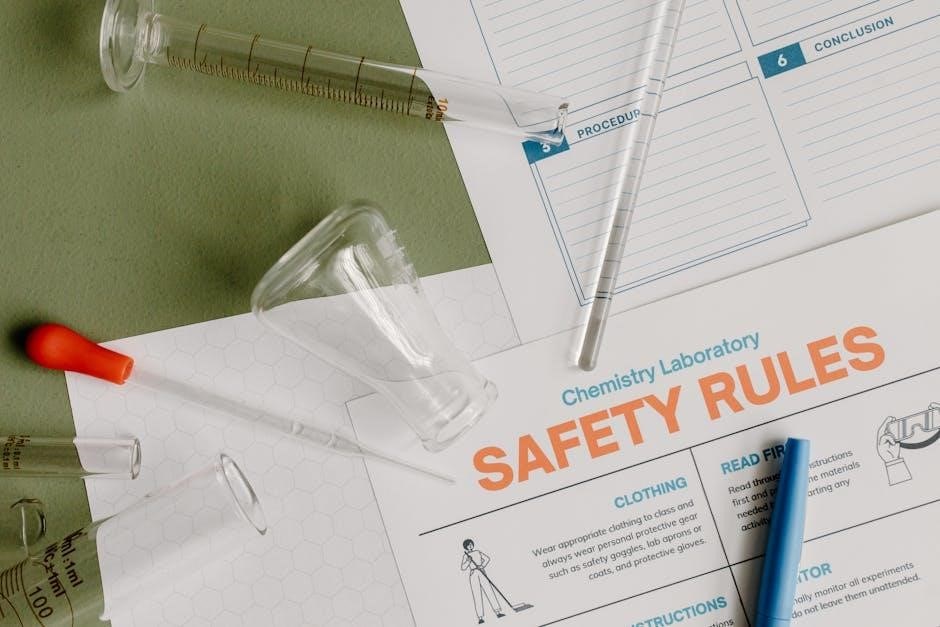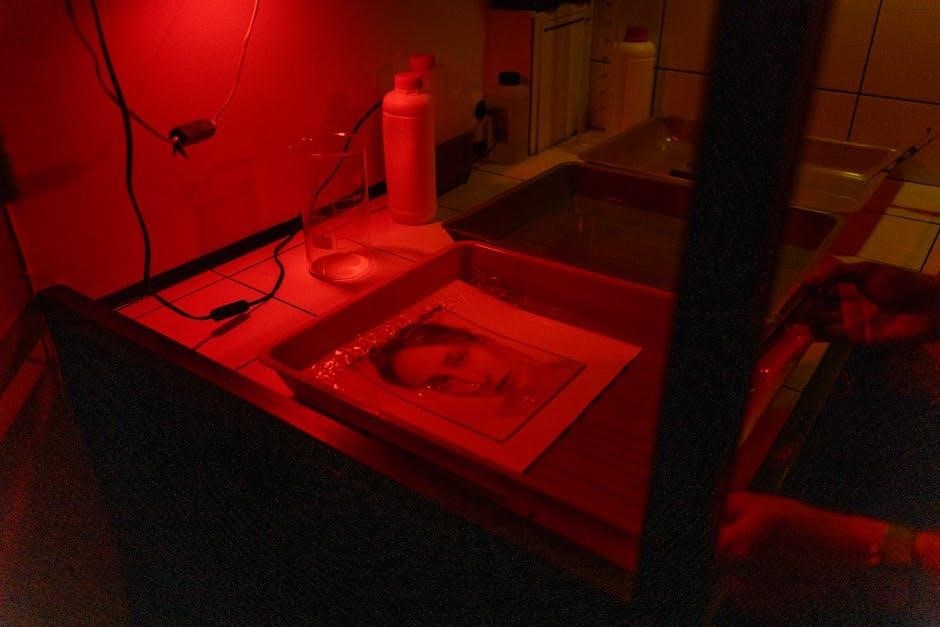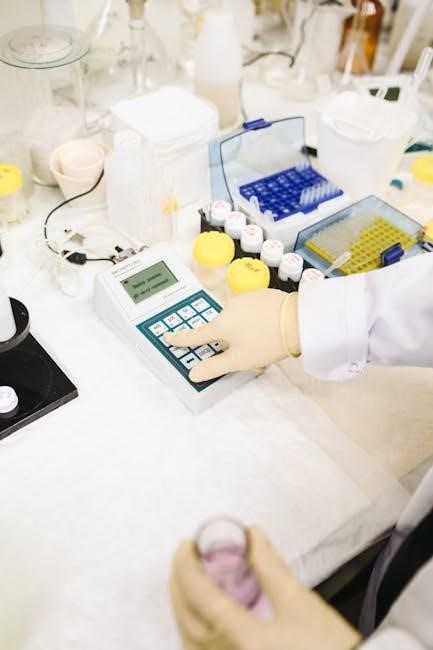chemistry lab manual
Summary
Discover the ultimate chemistry lab manual with practical experiments and step-by-step procedures for water treatment. Perfect for students and professionals.

Welcome to the Chemistry Lab Manual, your guide to mastering chemistry experiments. This manual provides detailed procedures, safety protocols, and tips for successful lab work, ensuring a comprehensive learning experience.
1.1 Purpose and Scope of the Lab Manual
The Chemistry Lab Manual serves as a comprehensive guide for students, outlining procedures, safety protocols, and best practices for conducting experiments. It ensures a structured approach to learning, promoting understanding of chemical principles through hands-on experience.
Its scope includes essential techniques, data analysis, and reporting methods, providing a foundation for scientific inquiry and skill development in a chemistry laboratory setting.
1.2 Importance of Lab Manuals in Chemistry Education
A lab manual is essential for ensuring safety, standardization, and consistency in laboratory practices. It provides clear instructions, reducing errors and enhancing learning outcomes. By following structured procedures, students develop critical thinking, technical skills, and scientific writing abilities, preparing them for advanced research and real-world applications in chemistry.
Additionally, it serves as a valuable reference for troubleshooting experiments and understanding fundamental concepts, fostering a deeper appreciation for the scientific method and its practical applications.

Structure of a Chemistry Lab Report
2.1 Title Page and Abstract
The title page includes the experiment title, author’s name, institution, and date. The abstract provides a concise summary of the experiment’s purpose, methods, results, and conclusions, offering a clear overview for readers.
The introduction sets the stage by explaining the experiment’s purpose, background, and significance. It provides context and reviews relevant theories. The objective clearly states what the experiment aims to achieve or demonstrate, ensuring clarity and focus for the investigation.
2.3 Materials and Methods
This section lists all materials and equipment used in the experiment, ensuring reproducibility. It details the step-by-step procedure, describing how to prepare solutions, conduct measurements, and perform analysis. Clear, concise instructions guide readers through the experimental process, emphasizing safety and precision throughout.
2.4 Results and Analysis
This section presents the data collected during the experiment, including measurements, observations, and calculations. Results are displayed clearly, often using graphs or tables, to facilitate understanding. The analysis interprets the data, discussing trends, patterns, and deviations, while ensuring accuracy and reproducibility of the findings.
2.5 Discussion and Conclusion
The discussion interprets the results, linking them to the experiment’s objectives and theoretical expectations. It highlights patterns, anomalies, and implications. The conclusion summarizes key findings, restating the experiment’s purpose and its significance. This section provides a clear, concise overview, enabling readers to understand the experiment’s outcomes and their broader relevance.
Safety Protocols in the Chemistry Lab
Safety is paramount in the chemistry lab. Always wear PPE, including goggles and gloves, and follow proper procedures for handling hazardous materials. Familiarize yourself with emergency exits and equipment to ensure preparedness in case of accidents or spills.
3.1 Personal Protective Equipment (PPE)
Personal Protective Equipment (PPE) is essential for protection in the chemistry lab. Wear a lab coat, goggles, gloves, and closed-toe shoes at all times. Tie back long hair and avoid loose jewelry to prevent accidents. These items protect against chemical splashes, spills, and thermal hazards, ensuring a safe working environment.
3.2 Hazardous Chemical Handling
Handling hazardous chemicals requires strict adherence to safety guidelines. Always read and understand Safety Data Sheets (SDS) before use. Use appropriate gloves, goggles, and lab coats to prevent exposure. Work in well-ventilated areas or under fume hoods to avoid inhaling toxic fumes. Ensure proper labeling and storage of all chemicals to minimize risks.
3.3 Emergency Procedures
In case of emergencies, evacuate the area immediately and alert others. Use fire extinguishers for small fires and spill kits for chemical leaks. Provide first aid for exposure or injuries. Contact lab supervisors or emergency services promptly. Familiarize yourself with exit routes and emergency equipment locations to ensure quick responses during incidents.
Common Laboratory Techniques
Master essential lab techniques like titration, filtration, and spectrophotometry. These methods ensure accurate measurements, separations, and analyses, forming the foundation of successful chemistry experiments and data interpretation.
4.1 Measurement and Calibration
Accurate measurement and calibration are critical in chemistry labs. Use instruments like balances, pipettes, and burettes correctly to ensure precision. Regular calibration of equipment prevents errors. Proper techniques in measuring volumes and masses are essential for reliable experimental results and data analysis.
4.2 Separation Techniques (Filtration, Distillation)
Filtration and distillation are essential separation techniques in chemistry labs. Filtration separates solids from liquids using a porous medium, while distillation isolates components based on differing boiling points. These methods ensure purity and precision in experimental results, making them vital for accurate chemical analysis and synthesis processes in various laboratory settings every day effectively.
4.3 Analytical Methods (Titration, Spectrophotometry)
Titration determines the concentration of a substance by reacting it with another of known concentration. Spectrophotometry measures light absorption to quantify substances. Both methods are critical for precise chemical analysis, ensuring accuracy and reliability in experimental results and quality control processes in chemistry labs and research settings daily.

Experimental Design and Setup
Experimental design involves planning procedures, defining variables, and setting objectives. Proper setup ensures controlled conditions, accurate data collection, and reproducibility, forming the foundation for valid and reliable results in chemistry experiments.
5.1 Developing a Hypothesis
Developing a hypothesis involves stating a testable prediction based on observations and research. It guides experimental design and provides a clear direction for investigation; A strong hypothesis is specific, measurable, and aligns with the experiment’s objectives, ensuring focused and meaningful data collection in chemistry labs.
5.2 Planning Procedures
Planning procedures involves outlining clear, step-by-step actions to achieve experiment objectives. It requires identifying materials, equipment, and safety protocols. A well-structured plan ensures efficient use of time, minimizes errors, and aligns with lab safety guidelines, promoting a systematic approach to conducting chemistry experiments effectively.
5.3 Recording Observations
Recording observations involves accurately documenting all data, including measurements, reactions, and unusual occurrences. Notes should be clear, concise, and organized, ensuring reproducibility. Use charts or tables for quantitative data and descriptive notes for qualitative observations. This step is crucial for drawing valid conclusions and refining experimental procedures.
Data Analysis and Interpretation
Data analysis involves evaluating experimental results, identifying trends, and assessing accuracy. Use graphical methods and statistical tools to interpret findings, ensuring conclusions align with observed data and experimental goals.
6.1 Graphical Representation of Data
Graphical representation simplifies data interpretation, showcasing trends and relationships. Use bar graphs, line charts, or scatter plots to present results clearly. Ensure axes are labeled, legends are included, and avoid unnecessary 3D effects. Consistency in formatting enhances readability and comparability of datasets across experiments.
6.2 Error Analysis and Precision
Error analysis evaluates uncertainties in measurements, ensuring data reliability. Precision reflects consistency across repeated trials. Use standard deviations or percentage errors to quantify accuracy. Proper error handling strengthens conclusions, demonstrating method reliability and result validity in experimental chemistry.
6.3 Drawing Valid Conclusions
Drawing valid conclusions involves interpreting data accurately and linking results to the experiment’s hypothesis. Ensure conclusions are supported by evidence, avoiding assumptions. Clearly explain how findings align with expected outcomes or reveal new insights, providing a logical and concise summary of the experiment’s significance and implications.

Common Chemistry Lab Experiments
Explore the preparation of chemical compounds through controlled reactions, such as acid-base neutralization or precipitation. Learn stoichiometric calculations, purification techniques, and characterization methods to ensure product purity and accuracy in synthesis.
7.1 Acid-Base Reactions
Acid-base reactions are fundamental experiments demonstrating neutralization principles. Students explore reactions between acids (e.g., HCl) and bases (e.g., NaOH), observing pH changes, heat release, and salt formation. These experiments emphasize stoichiometric calculations, indicator usage, and the importance of precise measurements to understand chemical behavior and safety protocols in lab settings.
7.2 Stoichiometry and Limiting Reagents
Stoichiometry involves calculating reactant and product amounts based on balanced equations. Limiting reagents determine the maximum product formed. Labs focus on accurate measurements, predictions of yields, and optimizing resource use. These experiments highlight the practical application of chemical equations and molar relationships, essential for understanding reaction efficiency and outcomes in chemistry.
7.3 Synthesis of Chemical Compounds
Chemical synthesis involves combining substances to form new compounds, demonstrating principles of chemical reactions and bonding. Labs emphasize precise measurements, purification methods, and characterization techniques. These experiments teach students to predict outcomes, optimize yields, and understand the practical applications of chemical synthesis in various industries and research settings, fostering hands-on learning and problem-solving skills.
Lab Equipment and Instrumentation
Lab equipment and instrumentation are essential tools for conducting precise chemical experiments. They facilitate accurate measurements, analysis, and experimentation, ensuring safety and efficiency in scientific inquiry and discovery.
8.1 Glassware and Apparatus
Common glassware includes beakers, test tubes, and flasks, used for mixing, heating, and storing chemicals. Apparatus like Bunsen burners and burettes are essential for specific procedures, ensuring precise control and measurement in experiments.
Proper handling and maintenance of glassware and apparatus are crucial for safety and accuracy, preventing contamination and equipment damage while conducting chemical experiments.
8.2 Instrumentation (Balances, Spectrophotometers)
Instrumentation is vital for precise measurements and analyses. Balances measure mass accurately, while spectrophotometers analyze light absorption, aiding in chemical identification and concentration determination. Proper calibration and maintenance ensure reliable results, making these tools indispensable in modern chemistry labs for both research and educational settings.
8.3 Maintenance and Calibration
Regular maintenance and calibration of lab equipment ensure accuracy and functionality. Clean instruments, lubricate moving parts, and inspect for wear. Calibration involves comparing readings with standards to adjust for precision. Proper maintenance prolongs equipment life and ensures reliable results, while calibration guarantees accurate measurements, both critical for safe and effective lab operations.
Best Practices for Lab Work
Adopting best practices in lab work ensures efficiency and safety. Stay organized, follow protocols, manage waste responsibly, and continuously improve techniques for optimal outcomes.
9.1 Organization and Time Management
Effective organization and time management are crucial for successful lab work. Prepare all materials beforehand, plan experiments with clear objectives, and create a schedule. Use timelines and checklists to track progress. Maintain a tidy workspace, label everything clearly, and keep records updated to ensure efficiency and accuracy in your experiments.
9.2 Collaborative Work and Peer Review
Collaborative work fosters learning and problem-solving. Encourage open communication with peers, share ideas, and divide tasks to enhance efficiency. Peer review helps improve lab reports and ensures accuracy. Regular discussions and feedback sessions promote mutual understanding and refinement of experimental techniques, enriching the overall lab experience and outcomes.
9.4 Waste Disposal and Sustainability
Proper waste disposal is crucial for environmental safety. Segregate hazardous and non-hazardous materials, using labeled containers. Adhere to institutional regulations for chemical disposal. Promote sustainability by minimizing waste, recycling materials, and using eco-friendly alternatives. Ensure responsible handling of resources to reduce the lab’s environmental impact and foster a greener future.
Troubleshooting Common Lab Issues
This section provides practical advice for addressing common lab challenges, ensuring experiments proceed smoothly and safely. Learn to identify and resolve issues effectively with ease.
10.1 Identifying Experimental Errors
Recognizing errors is crucial for valid results. Common mistakes include measurement inaccuracies, improper equipment use, and miscalculations. Regularly review procedures and data to detect discrepancies early, ensuring accurate outcomes and reliable conclusions in your experiments.
10.2 Adjusting Procedures Mid-Experiment
If discrepancies arise, promptly reassess and modify procedures to ensure accuracy. This may involve recalibrating instruments, remeasuring reagents, or adjusting experimental conditions. Document all changes to maintain transparency and validity in your results, ensuring the integrity of your scientific investigation.
10.3 Recovering from Accidents or Mishaps
In case of accidents, remain calm and act swiftly. Contain spills, evacuate if necessary, and report incidents immediately. Document what occurred and implement corrective actions to prevent future mishaps. Learning from errors enhances safety and improves experimental outcomes in future lab sessions.

Resources for Further Learning
Explore recommended textbooks, online tutorials, and scientific journals for deeper understanding. Utilize digital platforms offering video guides and interactive simulations to enhance your chemistry lab skills and knowledge effectively.
11.1 Recommended Textbooks and Guides
Key textbooks include “Chemistry Lab Manual” by ME Lewiston and “Scientific Writing Guide.” These resources provide detailed instructions on lab reports, safety protocols, and experimental procedures. Additionally, online guides offer step-by-step tutorials and visual aids to enhance understanding and practical skills in chemistry laboratory settings effectively.
11.2 Online Tutorials and Videos
Online tutorials and videos are invaluable resources for chemistry lab manual topics. Platforms like YouTube and Coursera offer detailed video guides, while websites provide interactive simulations. These tools help students visualize experiments, understand complex techniques, and review procedures at their own pace, enhancing their learning experience and practical skills effectively.
11.3 Scientific Journals and Articles
Scientific journals and articles are essential resources for advancing knowledge in chemistry. They provide detailed research, methodologies, and findings, enabling students to explore advanced topics and stay updated on recent discoveries. Accessing reputable databases like PubMed or ScienceDirect offers a wealth of peer-reviewed articles for deeper learning and academic growth.
The Chemistry Lab Manual serves as a comprehensive guide, equipping students with essential skills and knowledge. By following its structured approach, learners can confidently conduct experiments, analyze data, and draw meaningful conclusions. Continuous practice and exploration will further enhance their understanding, fostering a deeper appreciation for chemistry and its applications.
12.1 Summary of Key Concepts
The Chemistry Lab Manual emphasizes safety, precise measurement, and clear documentation. It highlights experimental design, data analysis, and interpretation. Key concepts include following protocols, maintaining organization, and applying theoretical knowledge to practical procedures. These principles ensure accurate results, fostering a strong foundation in chemistry and scientific inquiry.
12.2 Encouragement for Continuous Learning
Embrace curiosity and stay proactive in exploring chemistry concepts. Continuous learning enriches your understanding and skillset. Engage with additional resources, practice regularly, and seek feedback to refine your techniques. Remember, challenges are opportunities for growth, fostering a deeper appreciation for the scientific process and its applications.